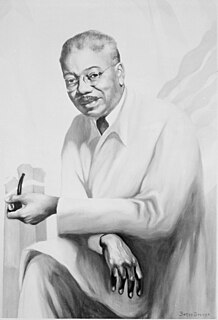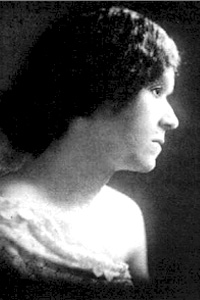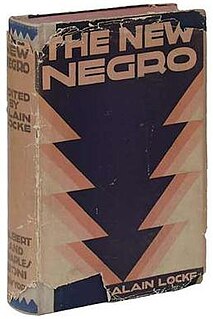
Jessie Redmon Fauset was an African-American editor, poet, essayist, novelist, and educator. Her literary work helped sculpt African-American literature in the 1920s as she focused on portraying a true image of African-American life and history. Her black fictional characters were working professionals which was an inconceivable concept to American society during this time Her story lines related to themes of racial discrimination, "passing", and feminism. From 1919 to 1926, Fauset's position as literary editor of The Crisis, a NAACP magazine, allowed her to contribute to the Harlem Renaissance by promoting literary work that related to the social movements of this era. Through her work as a literary editor and reviewer, she discouraged black writers from lessening the racial qualities of the characters in their work, and encouraged them to write honestly and openly about the African-American race. She wanted a realistic and positive representation of the African-American community in literature that had never before been as prominently displayed. Before and after working on The Crisis, she worked for decades as a French teacher in public schools in Washington, DC, and New York City. She published four novels during the 1920s and 1930s, exploring the lives of the black middle class. She also was the editor and co-author of the African-American children's magazine The Brownies' Book. She is known for discovering and mentoring other African-American writers, including Langston Hughes, Jean Toomer, Countee Cullen, and Claude McKay.

Aaron Douglas was an American painter, illustrator and visual arts educator. He was a major figure in the Harlem Renaissance. He developed his art career painting murals and creating illustrations that addressed social issues around race and segregation in the United States by utilizing African-centric imagery. Douglas set the stage for young, African-American artists to enter public arts realm through his involvement with the Harlem Artists Guild. In 1944, he concluded his art career by founding the Art Department at Fisk University in Nashville, Tennessee. He taught visual art classes at Fisk until his retirement in 1966. Douglas is known as a prominent leader in modern African-American art whose work influenced artists for years to come.

Wallace Henry Thurman was an American novelist active during the Harlem Renaissance. He also wrote essays, worked as an editor, and was a publisher of short-lived newspapers and literary journals. He is best known for his novel The Blacker the Berry: A Novel of Negro Life (1929), which explores discrimination within the black community based on skin color, with lighter skin being more highly valued.

Richard Bruce Nugent, aka Richard Bruce and Bruce Nugent, was a queer writer and painter in the Harlem Renaissance. Despite being a part of a group of many gay Harlem artists, Nugent was among only a few who were publicly out. Recognized initially for the few short stories and paintings that were published, Nugent had a long productive career bringing to light the creative process of gay and black culture.

Rudolph John Chauncey Fisher was an African-American physician, radiologist, novelist, short story writer, dramatist, musician, and orator. His father was John Wesley Fisher, a clergyman, his mother was Glendora Williamson Fisher, and he had two siblings. Fisher married Jane Ryder, a school teacher from Washington, D.C. in 1925, and they had one son, Hugh, who was born in 1926 and was also nicknamed "The New Negro" as a tribute to the Harlem renaissance.

Survey Graphic (SG) was a United States magazine launched in 1921. From 1921 to 1932, it was published as a supplement to The Survey and became a separate publication in 1933. SG focused on sociological and political research and analysis of national and international issues. Bidding his readers to "embark on a voyage of discovery", editor Paul Kellogg used a metaphor of a ship in his inaugural remarks for the new magazine: "Survey Graphic will reach into the corners of the world — America and all the Seven Seas — to wherever the tides of a generous progress are astir." Article topics included fascism, anti-Semitism, poverty, unions and the working class, and education and political reform. The magazine ceased publication in 1952.

Georgia Blanche Douglas Camp Johnson, better known as Georgia Douglas Johnson, was an African-American poet, one of the earliest African-American female playwrights, and an important participant in the Harlem Renaissance.

Alain Leroy Locke was an American writer, philosopher, educator, and patron of the arts. Distinguished as the first African-American Rhodes Scholar in 1907, Locke was the philosophical architect —the acknowledged "Dean"— of the Harlem Renaissance. As a result, popular listings of influential African Americans have repeatedly included him. On March 19, 1968, the Rev. Dr. Martin Luther King, Jr. proclaimed: "We're going to let our children know that the only philosophers that lived were not Plato and Aristotle, but W. E. B. Du Bois and Alain Locke came through the universe."
The Harlem Renaissance was an intellectual, social, and artistic explosion centered in Harlem, New York, spanning the 1920s. At the time, it was known as the "New Negro Movement", named after The New Negro, a 1925 anthology edited by Alain Locke. The movement also included the new African-American cultural expressions across the urban areas in the Northeast and Midwest United States affected by the Great Migration, of which Harlem was the largest.

Malvin Gray Johnson was an African-American painter, born and raised in Greensboro, North Carolina.
Lewis Grandison Alexander was an American poet, actor, playwright, and costume designer who lived in Washington, D.C. and had strong ties to the Harlem Renaissance period in New York. Alexander focused most of his time and creativity on poetry, and it is for this that he is best known.
A black mecca, in the United States, is a city to which African Americans, particularly singles, professionals, and middle-class families, are drawn to live, due to some or all of the following factors:
James Latimer Allen (1907–1977) was a photographer and portraitist known for his images of the Harlem Renaissance of the 1920s and 1930s.
Arthur Paul Davis (1904–1996) was an influential, African-American university teacher, literary scholar, and the author and editor of several important critical texts such as The Negro Caravan, The New Cavalcade, and From the Dark Tower: Afro-American Writers 1900–1960. Influenced by the Harlem Renaissance, Davis has inspired many African-Americans to pursue literature and the arts.
Wilfred Adolphus Domingo of Kingston, Jamaica, was an activist and journalist who became the youngest editor of Marcus Garvey's newspaper the Negro World. As an activist and writer, Domingo travelled to the United States advocating for Jamaican sovereignty as a leader of the African Blood Brotherhood and the Harlem branch of the Socialist Party.
Manet Harrison Fowler was an American musician, dramatic soprano, artist, voice coach, piano teacher and music educator. She was a child prodigy, giving piano recitals at the age of six. A native of Fort Worth, Texas she founded the Mwalimu School for the development of African Music and Creative Art in 1928 and relocated to New York City during the Harlem Renaissance. She was President of the Texas Association of Negro Musicians (TANM), the first state branch of the National Association of Negro Musicians.
Jeffrey Conrad Stewart is an American Professor of Black Studies at the University of California, Santa Barbara. He won the 2019 Pulitzer Prize in Biography for The New Negro: The Life of Alain Locke.









